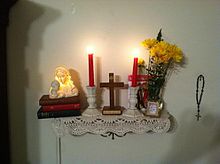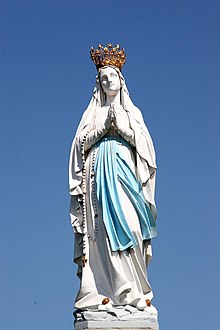Christian prayer
[3][4][5] The early Christians thus came to recite the Lord's Prayer thrice a day at 9 am, 12 pm, and 3 pm, supplanting the former Amidah predominant in the Hebrew tradition;[6][7][8] as such, many Lutheran and Anglican churches ring their church bells from belltowers three times a day: in the morning, at noon and in the evening summoning the Christian faithful to recite the Lord’s Prayer.[27] Among Old Ritualists, a prayer rug known as a Podruchnik is used to keep one's face and hands clean during prostrations, as these parts of the body are used to make the sign of the cross.[28] Spontaneous prayer in Christianity, often done in private settings, follows the basic form of adoration, contrition, thanksgiving and supplication, abbreviated as A.C.T.S.[35] Origen's methods of interpreting Scripture and praying on them were learned by Ambrose of Milan, who towards the end of the 4th century taught them to Augustine of Hippo, thereby introducing them into the monastic traditions of the Western Church thereafter.[38][39] These early communities gave rise to the tradition of a Christian life of "constant prayer" in a monastic setting which eventually resulted in meditative practices in the Eastern Church during the Byzantine period.[39][40] In the Western Church, by the 6th century, Benedict of Nursia and Pope Gregory I had initiated the formal methods of scriptural prayer called Lectio Divina.[44] Bernard also emphasized the role of the Holy Spirit in contemplative prayer and compared it to a kiss by the Eternal Father which allows a union with God.[45] The progression from Bible reading, to meditation, to loving regard for God, was first formally described by Guigo II, a Carthusian monk who died late in the 12th century.[46] Guigo II's book The Ladder of Monks is considered the first description of methodical prayer in the western mystical tradition.[47] In Eastern Christianity, the monastic traditions of "constant prayer" that traced back to the Desert Fathers and Evagrius Pontikos established the practice of hesychasm and influenced John Climacus' book The Ladder of Divine Ascent by the 7th century.[49][39] In the Western Church, during the 15th century, reforms of the clergy and monastic settings were undertaken by the two Venetians, Lorenzo Giustiniani and Louis Barbo.Based on the request of Pope Eugene IV, Barbo introduced these methods to Valladolid, Spain and by the end of the 15th century they were being used at the abbey of Montserrat.Many denominations use specific prayers geared to the season of the Christian Liturgical Year, such as Advent, Christmas, Lent and Easter.Christian meditation is the process of deliberately focusing on specific thoughts (such as a bible passage) and reflecting on their meaning in the context of the love of God.[75] This kind of prayer involves the believer taking the role of an intercessor, praying on behalf of another individual, group or community, or even a nation.Saint Augustine remarked that the Egyptian Christians who withdrew to a solitary life "are said to say frequent prayers, but very brief ones that are tossed off as in a rush, so that a vigilant and keen intention, which is very necessary for one who prays, may not fade away and grow dull over longer periods".








prie-dieuvotive candleshome altarChristian devotional literatureChristianityChristNativityBaptismMinistryCrucifixionResurrectionAscensionOld TestamentNew TestamentGospelChurchNew CovenantTheologyTrinityFatherHoly SpiritApologeticsChristologyHistory of theologyMissionSalvationUniversalismHistoryTraditionApostlesEarly ChristianityChurch FathersConstantineCouncilsAugustineIgnatiusEast–West SchismCrusadesAquinasReformationLutherDenominations(full list)NiceneCatholicEasternOld CatholicPalmarian CatholicIndependent CatholicSedevacantismEastern OrthodoxOriental OrthodoxChurch of the EastProtestantAdventistAnabaptistAnglicanBaptistFree EvangelicalLutheranMethodistMoravian [Hussite]PentecostalPlymouth BrethrenQuakerReformedUnited ProtestantWaldensianNondenominational ChristianityRestorationistChristadelphiansIglesia ni CristoIrvingiansJehovah's WitnessesLatter Day SaintsMembers Church of God InternationalThe Church of Jesus Christ of Latter-day SaintsThe New Church (Swedenborgian)Unitarians and UniversalistsCivilizationCriticismCultureEcumenismGlossaryLiturgyOther religionsSermonSymbolismWorshipOutlinebreviarycanonical hoursfixed prayer timeskneelerLord's PrayerdisciplesDidacheJewishDanielAmidahchurch bellsbelltowersearly Churchseven fixed prayer timesApostolic TraditionHippolytusOriental Orthodox ChristiansAgpeyaShehimoeastward directionSecond Coming of Jesusshoes are removedChristian denominationsChristian headcoveringChristian crosseastward direction of prayerLord's Daymany Christian assemble collectivelyLutheran Service BookBook of Common Prayerejaculatory prayersextemporaneouscamp meetingsdaily devotionalprayer bookWestern Christianity
